County Cavan, located in the heart of Ireland, is a region steeped in history and filled with landmarks that tell the story of Ireland’s past. From prehistoric burial sites to medieval castles and early Christian monasteries, historical sites in Cavan offer a fascinating glimpse into the rich tapestry of Irish history. Whether you’re a history enthusiast or a casual traveler, these sites provide a captivating journey through time.
In this article, we’ll explore some of the most significant historical landmarks in Cavan, delving into their history and what makes them worth visiting. This guide will help you plan your journey to uncover the hidden treasures of County Cavan. For a complete list of must-see places and activities, visit our guide on Things to Do in County Cavan.
Table of contents
- Cavan Burren Park: Ireland’s Ancient Past
- Castle Saunderson: A Historic Estate with a Complex Past
- Drumlane Abbey and Round Tower: Early Christian Ireland
- Cavan County Museum: A Treasure Trove of Local History
- Cloughoughter Castle: A Tower in the Middle of Lough Oughter
- Other Notable Historical Sites in Cavan
- FAQs About Historical Sites in Cavan
Cavan Burren Park: Ireland’s Ancient Past
One of the most remarkable historical sites in Cavan, Cavan Burren Park is a prehistoric landscape filled with ancient tombs, megalithic monuments, and stone carvings.
Dating back thousands of years, this park offers visitors a chance to walk in the footsteps of Ireland’s earliest inhabitants.
Historical Significance:
- Megalithic Tombs: These Neolithic burial sites are among the oldest historical structures in Ireland.
- Ancient Rock Art: Intricate carvings on the rocks offer a glimpse into the artistic expressions of ancient communities.
- Geological Features: The park is also known for its fascinating geological formations, shaped by glaciers during the Ice Age.
Why Visit?
Cavan Burren Park combines history and natural beauty, making it a must-see for anyone interested in Ireland’s ancient past.
Castle Saunderson: A Historic Estate with a Complex Past
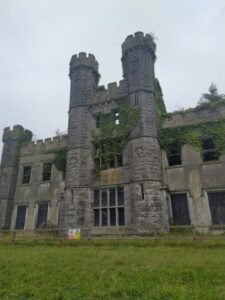
Next on the list of Cavan’s historical sites is Castle Saunderson, a 17th-century estate with a rich and complex history. Originally built by the Saunderson family, this castle played a significant role in the Plantation of Ulster, a crucial period in Irish history.
Key Highlights:
- Castle Grounds: The extensive estate is perfect for leisurely walks while soaking in the castle’s architectural beauty.
- Historical Importance: The castle’s history is intertwined with the events of the Plantation of Ulster, a pivotal moment in the colonization of Ireland by the English and Scots.
Why Visit?
Castle Saunderson offers both a historical and cultural experience, with its lush grounds and centuries-old architecture providing a window into Cavan’s past.
Drumlane Abbey and Round Tower: Early Christian Ireland
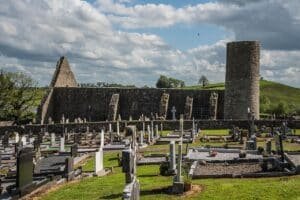
Image by Milltown – Drumlane, licensed under CC BY 4.0.
One of the most iconic early Christian historical sites in Cavan is Drumlane Abbey and Round Tower, dating back to the 6th century.
Founded by St. Colmcille, the abbey and its round tower are important religious landmarks that offer breathtaking views of the surrounding countryside.
Notable Aspects:
- Round Tower: One of the few remaining round towers in Ireland, it stands as a symbol of Ireland’s early Christian era.
- Monastic Ruins: The remains of the abbey offer insight into the monastic life that shaped Ireland’s religious history.
- Scenic Location: Located near Lough Oughter, the area provides a serene backdrop for those interested in both history and nature.
Why Visit?
Drumlane Abbey and Round Tower not only provide a rich historical experience but also offer stunning views and a peaceful environment for visitors to reflect on Ireland’s early Christian roots.
Discover more about Drumlane Abbey here.
Cavan County Museum: A Treasure Trove of Local History
If you want a comprehensive look at Cavan’s history, the Cavan County Museum in Ballyjamesduff is a must-visit. This museum houses a variety of exhibits that span from prehistoric times to the modern era, making it an essential stop for history enthusiasts.
Key Highlights:
- World War I Trench Experience: A life-size replica of a World War I trench, giving visitors a unique perspective on the war’s impact on Ireland.
- Prehistoric Artifacts: Displays include ancient tools, pottery, and other artifacts that offer insight into the lives of Ireland’s earliest settlers.
- Historical Exhibits: Covering everything from the Anglo-Norman invasion to the Plantation of Ulster, the museum provides a detailed narrative of Cavan’s complex history.
Why Visit?
The museum is perfect for anyone looking to delve deeper into the rich history of County Cavan, offering both educational and interactive exhibits.
Cloughoughter Castle: A Tower in the Middle of Lough Oughter
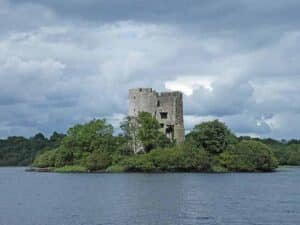
Image by Oliver Dixon, licensed under CC BY-SA 2.0.
Standing on a small island in Lough Oughter, Cloughoughter Castle is one of the most visually striking historical sites in Cavan.
Built in the early 13th century by the Anglo-Normans, the castle has witnessed key moments in Ireland’s turbulent history.
Key Highlights:
- Island Location: The castle is located on an island in Lough Oughter, which adds to its mystique and historical significance.
- Medieval Architecture: As a cylindrical tower, it represents the transition from early Norman stone castles to more fortified structures.
- Siege History: Cloughoughter Castle played a critical role during the Irish Confederate Wars and was one of the last strongholds to fall.
Why Visit?
The remote location and dramatic setting make Cloughoughter Castle a unique historical site, offering a picturesque and reflective visit.
Other Notable Historical Sites in Cavan
In addition to the well-known historical landmarks, County Cavan is home to several lesser-known but equally fascinating sites that provide unique insights into the region’s rich history. These hidden gems are perfect for those who want to explore beyond the typical tourist trail.
Killeshandra: A Plantation-Era Village
Killeshandra, a small town in County Cavan, has deep historical ties to the Plantation of Ulster, which dramatically shaped the region’s landscape in the 17th century.
The town was developed during this period and features several remnants from this era, including old churches and buildings that reflect the architecture of the time.
Historical Significance:
- Plantation of Ulster: Killeshandra’s growth is closely linked to the British government’s efforts to settle English and Scottish Protestants in Ulster during the 17th century.
- Church of Ireland: The local Church of Ireland building is a testament to the religious changes that took place during the Plantation period.
Why Visit?
Killeshandra offers a quieter, more intimate look into the history of the Plantation of Ulster, providing visitors with a better understanding of how these settlements shaped local communities.
Tullydermot Falls: A Blend of Natural Beauty and Historical Significance
Though Tullydermot Falls is primarily known for its stunning natural beauty, the area surrounding the falls has historical roots that date back to ancient Irish settlements.
The falls are located near the Cuilcagh Mountains, a region with ties to early Irish clans and historical trade routes.
Historical Significance:
- Ancient Settlements: The area around Tullydermot Falls was once home to early Irish settlers, with evidence of their presence still found in the landscape.
- Clann Connections: Historically, the region was controlled by Irish clans, such as the O’Reilly and Maguire families, who played a significant role in Cavan’s history.
Why Visit?
Visitors to Tullydermot Falls can enjoy a serene natural setting while also exploring the area’s rich historical past. It’s a perfect destination for history buffs who appreciate natural beauty and hidden historical gems.
Bawnboy Workhouse: A Glimpse into Famine-Era Ireland
The Bawnboy Workhouse, located in the village of Bawnboy, serves as a stark reminder of the hardships faced by the Irish during the Great Famine in the 19th century.
Built in the 1850s, the workhouse was one of many across Ireland where impoverished people sought refuge during the famine, which devastated much of the country.
Historical Significance:
- Great Famine: The workhouse stands as a poignant reminder of one of the most tragic periods in Irish history, when thousands of people were forced to live in workhouses due to starvation and poverty.
- Famine Architecture: The building is a well-preserved example of famine-era architecture, with its stark and functional design reflecting the difficult conditions faced by those who lived there.
Why Visit?
Bawnboy Workhouse offers a sobering but important glimpse into the social history of Ireland during the Great Famine. Visitors can learn about the hardships endured by the Irish people and the resilience they showed during this challenging time.
Lough Sheelin: A Tranquil Spot with Historical Echoes
While Lough Sheelin is widely known for its fishing and serene beauty, the surrounding area has historical ties that date back centuries.
The lake’s shores were once the site of ancient settlements and battles, offering visitors a peaceful escape with a historical edge.
Historical Significance:
- Ancient Settlements: Archaeological finds near Lough Sheelin suggest that the area was settled by early Irish inhabitants thousands of years ago.
- Battle of Lough Sheelin: The lake was the site of a notable battle between Irish clans, adding a layer of historical intrigue to the tranquil surroundings.
Why Visit?
Lough Sheelin offers visitors the chance to enjoy a peaceful day of fishing or relaxation while reflecting on the area’s deep-rooted historical significance.
Ballyconnell: A Historic Town on the Shannon-Erne Waterway
Ballyconnell, located on the Shannon-Erne Waterway, has a rich history that dates back to ancient times. The town has served as a key crossing point and settlement throughout Ireland’s history, with notable archaeological finds that reflect its importance in both prehistoric and medieval times.
Historical Significance:
- Shannon-Erne Waterway: Ballyconnell’s location on this major waterway made it an important settlement for trade and travel during ancient and medieval times.
- Ancient Burial Grounds: The area around Ballyconnell has yielded significant archaeological finds, including burial sites that offer insights into early Irish life.
Why Visit?
Ballyconnell is a charming town where visitors can explore the intersection of history and nature, with the scenic waterway providing a beautiful backdrop to the town’s historical significance.
Marble Arch Caves: Geological Wonders and Early Human History
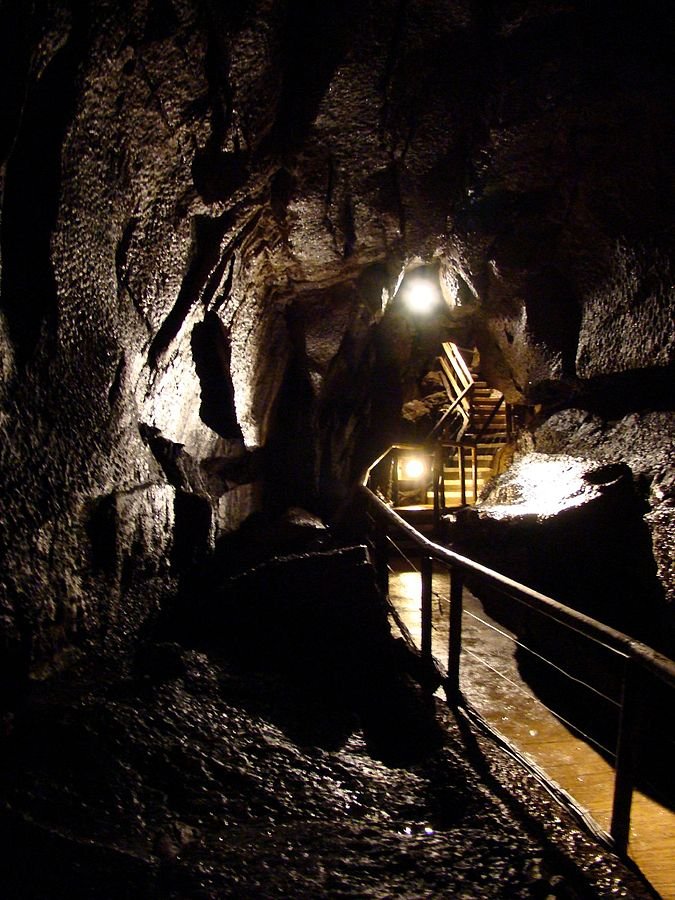
Image by Shadowgate, licensed under CC BY 2.0.
Although located just outside County Cavan, the Marble Arch Caves form part of the UNESCO Global Geopark that spans across the border into Cavan.
The caves, while best known for their impressive limestone formations, also have historical significance due to archaeological discoveries that suggest early human settlement in the area.
Historical and Geological Significance:
- Archaeological Findings: The area surrounding the Marble Arch Caves has yielded evidence of early human activity, offering a glimpse into how ancient peoples might have used the landscape for shelter and resources.
- Geological History: Formed over millions of years, the caves themselves represent an important chapter in the natural history of the region, with stunning stalactites and stalagmites that have fascinated visitors for centuries.
- UNESCO Global Geopark: This protected area connects both the natural and historical heritage of County Cavan and Fermanagh, offering visitors a comprehensive experience of the region’s deep-rooted history.
Why Visit?
The Marble Arch Caves are not just a natural wonder—they’re a link to the distant past, both in terms of geological time and early human history. Visitors can explore the awe-inspiring cave system and learn how the area played a role in shaping the history of the region.
The caves provide a perfect complement to the historical sites in Cavan, making them a must-visit for anyone interested in the deeper layers of Ireland’s past.
Conclusion
County Cavan is a region where history comes alive through its rich collection of ancient sites, medieval castles, early Christian monasteries, and even natural landmarks that reveal the geological history of the area.
From the prehistoric marvels of Cavan Burren Park to the medieval charm of Castle Saunderson, and the serene beauty of Drumlane Abbey to the solitude of Cloughoughter Castle, Cavan offers a unique glimpse into Ireland’s rich history.
Beyond these prominent landmarks, the county’s lesser-known historical gems, such as Killeshandra, Tullydermot Falls, and the poignant Bawnboy Workhouse, add layers of depth and authenticity to Cavan’s historical narrative.
For those willing to venture further, the nearby Marble Arch Caves offer a fascinating blend of natural and early human history, making it a perfect complement to your exploration of Cavan.
Whether you’re passionate about Irish history, intrigued by ancient ruins, or simply looking for a deeper connection with Ireland’s cultural heritage, County Cavan offers a wealth of historical sites that cater to all interests. Each landmark tells a story—of ancient peoples, early settlers, and key events that shaped the region’s identity.
Plan your visit to Cavan today, and immerse yourself in the rich historical tapestry that makes this county one of Ireland’s hidden treasures. Whether you’re exploring famous landmarks or uncovering hidden gems, Cavan promises a journey through time you won’t soon forget.
These historical sites are just a part of what County Cavan has to offer. Don’t miss out on other exciting activities by checking our comprehensive guide: Things to Do in County Cavan.
FAQs About Historical Sites in Cavan
Some of the most famous historical sites in Cavan include Cavan Burren Park with its ancient megalithic tombs, Castle Saunderson, the early Christian Drumlane Abbey, and the medieval Cloughoughter Castle. These sites offer rich insights into the region’s history, from prehistoric times to the medieval era.
Most historical sites in County Cavan, such as Cavan Burren Park and Drumlane Abbey, are free to visit. However, some sites like Cavan County Museum may have a small entrance fee for access to exhibitions. Always check ahead for specific site information.
Yes, many of Cavan’s historical sites are family-friendly. Sites like Cavan Burren Park offer nature trails that children can enjoy, while places like Cavan County Museum provide interactive exhibits that can engage younger visitors. Always ensure the site is safe and accessible for your family’s needs.
It depends on how many sites you wish to visit. If you’re exploring several key sites like Cavan Burren Park, Castle Saunderson, and Cloughoughter Castle, plan to spend at least 2-3 days in Cavan to fully appreciate the historical richness. Each site can take between 1 to 3 hours to explore.
Plan Your Visit to County Cavan Today!
Ready to explore the rich history of County Cavan? Whether you’re fascinated by ancient tombs, medieval castles, or early Christian landmarks, Cavan’s historical sites offer something for everyone. Start planning your trip today to uncover the hidden stories of Ireland’s past.
👉 Don’t miss out on the journey through time! Share this guide, follow us for more travel tips, and bookmark our website for future updates on Irish history and culture.

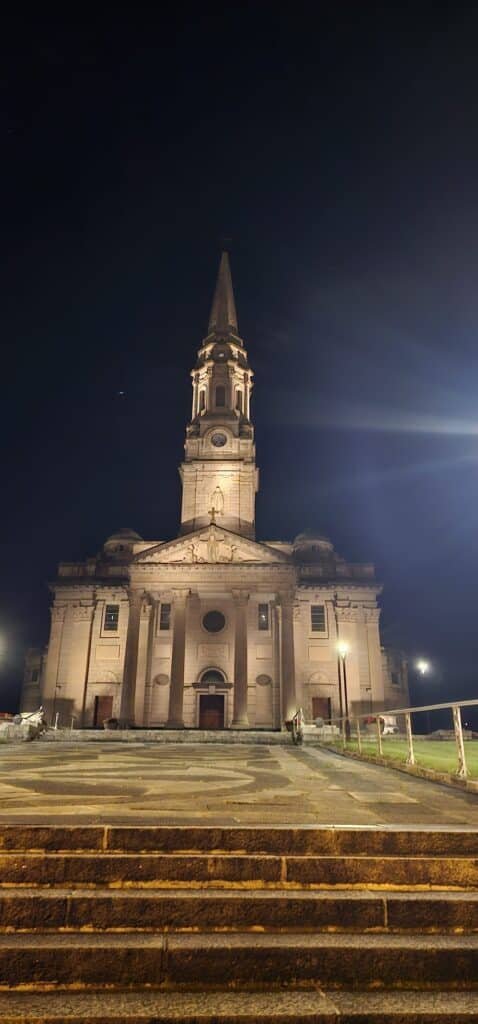
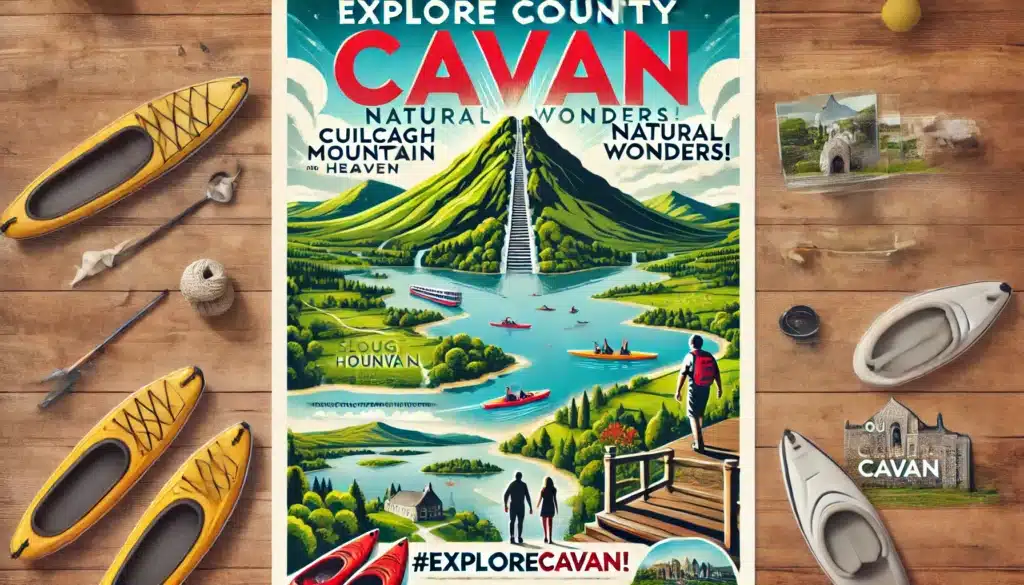
Pingback: Things to do in County Cavan
Pingback: Cultural and Heritage Experience in Cavan - Irish Roots
Pingback: Castle Saunderson Cavan
Pingback: Saunderson Church Cavan - Irish Roots
Pingback: Cavan Burren Park
Pingback: Best Autumn Walks Cavan Ireland
Pingback: Castle Cabra Kings Court